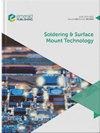The influence of SACX0307-ZnO nanocomposite solder alloys on the optical and thermal properties of power LEDs
IF 1.7
4区 材料科学
Q3 ENGINEERING, ELECTRICAL & ELECTRONIC
引用次数: 2
Abstract
Purpose This paper aims to present the results of investigations that show the influence of ZnO composite soldering paste on the optical and thermal parameters of power light-emitting diodes (LEDs). Design/methodology/approach ZnO nanocomposite solder alloys were produced via the ball milling process from the solder paste Sn99Ag0.3Cu0.7 (SACX0307) and 1.0 wt% of ZnO nanoparticle reinforcements with different primary particle sizes (200 nm, 100 nm and 50 nm). Power LEDs were soldered onto a metal core printed circuit board. A self-designed LED test system was used to measure the thermal and optical characteristics of the LEDs. Findings The influence of the soldering paste on the thermal and optical parameters of LEDs was observed. In all solder alloys, ZnO ceramic reinforcement, at a level of 1 wt%, increased the thermal parameters of LEDs and decreased their luminous efficiency. Thermal resistance values were10% higher, and junction temperature change over ambient temperature was 20% higher for the samples soldered with composite solder pastes than the reference sample. At the same time, luminous efficiency dropped by 32%. Originality/value The results prove that ZnO ceramic reinforcement of solder paste influences the thermal properties of solder joints. As was proven, the quality of the solder joints influences the whole assembly.SACX0307-ZnO纳米复合钎料合金对功率led光学和热性能的影响
目的研究ZnO复合焊膏对大功率发光二极管(led)光学和热学参数的影响。以锡膏Sn99Ag0.3Cu0.7 (SACX0307)和1.0 wt%的ZnO纳米颗粒增强剂(初级粒径分别为200nm、100nm和50nm)为原料,采用球磨法制备ZnO纳米复合钎料合金。电源led被焊接在一个金属核心印刷电路板上。采用自行设计的LED测试系统对LED的热学和光学特性进行了测试。结果观察了焊膏对led热、光学参数的影响。在所有钎料合金中,ZnO陶瓷增强剂在1 wt%的水平时,增加了led的热参数并降低了其发光效率。与参考样品相比,用复合焊膏焊接的样品的热阻值高出10%,结温随环境温度的变化高出20%。同时,发光效率下降了32%。研究结果表明,ZnO陶瓷增强锡膏会影响焊点的热性能。事实证明,焊点的质量影响整个装配。
本文章由计算机程序翻译,如有差异,请以英文原文为准。
求助全文
约1分钟内获得全文
求助全文
来源期刊

Soldering & Surface Mount Technology
工程技术-材料科学:综合
CiteScore
4.10
自引率
15.00%
发文量
30
审稿时长
>12 weeks
期刊介绍:
Soldering & Surface Mount Technology seeks to make an important contribution to the advancement of research and application within the technical body of knowledge and expertise in this vital area. Soldering & Surface Mount Technology compliments its sister publications; Circuit World and Microelectronics International.
The journal covers all aspects of SMT from alloys, pastes and fluxes, to reliability and environmental effects, and is currently providing an important dissemination route for new knowledge on lead-free solders and processes. The journal comprises a multidisciplinary study of the key materials and technologies used to assemble state of the art functional electronic devices. The key focus is on assembling devices and interconnecting components via soldering, whilst also embracing a broad range of related approaches.
 求助内容:
求助内容: 应助结果提醒方式:
应助结果提醒方式:


